Menu
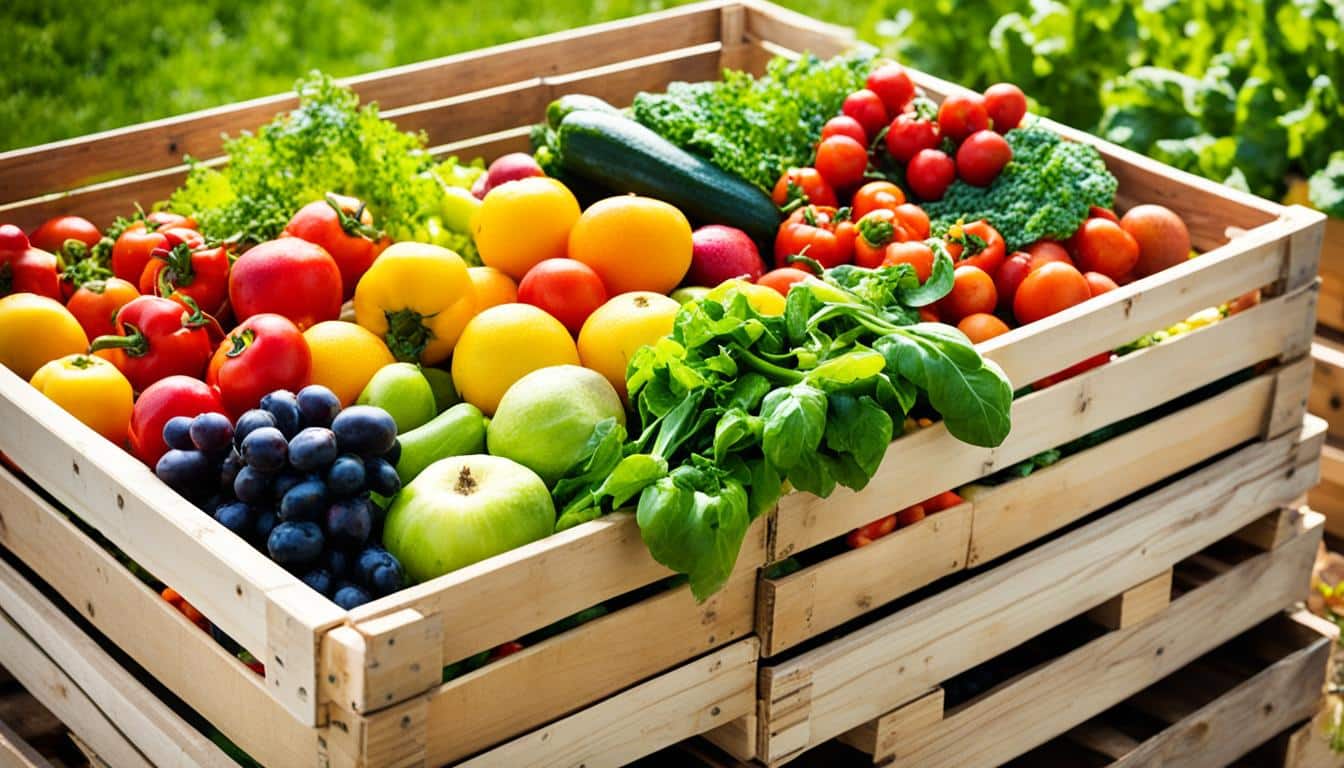
U.S. organic exports to Japan hit $80 million. They are expected to reach $250 million in a decade. This growth shows the world’s growing love for American organic goods. More people are choosing eco-friendly and healthy options. This is pushing farmers and small businesses to think about selling overseas to grow.
Trading organic produce, like the carrots you see below, can really boost small businesses and create jobs. Thanks to good partnerships, selling in countries like Canada, the EU, Japan, and Taiwan is easier. You don’t need as many extra certifications, so it’s simpler to get your goods into these markets.
The USDA’s AMS and FAS give great help to producers wanting to sell their organic crops abroad. They offer useful information and support. For example, sales to Japan are already at $80 million. Over the next ten years, they’re set to rise even more. Knowing about certifications and other rules is key. It ensures your organic goods are trusted from the farm to the world market.
Organic certification is crucial in the organic industry. It lets sellers and makers reach new markets. At the same time, it keeps organic goods trusted and true from start to finish. It also meets strict organic rules, helping to build faith and clear markets.
The USDA organic seal is a US gold standard for organic food. Only foods made exactly like the USDA wants can bear this seal. USDA-accredited experts check organic farms and companies each year. They also do surprise steps to keep the seal’s meaning true.
Getting certified is hard work and detailed for those with organic goods. Companies in the chain must keep careful records. This records keeping rule helps track products from farm to table. Yearly checks make sure everyone sticks to these rules, giving buyers confidence in what they’re getting.
Keeping organic products honest involves everyone who cares about being green. The National Organic Standards Board (NOSB) listen to folks at their meetings. This gives all a say in how things are done, making the process more trusted and strong.
| Aspect | Details |
|---|---|
| Government-backed | USDA organic label |
| Inspection Frequency | Annual, plus unannounced |
| Record-Keeping | Required for traceability |
| Stakeholder Input | NOSB public meetings |
People are happy to pay more for organic goods, up to 116% over regular prices. This shows how important the certification is to them. The US keeps seeing more sales of organic stuff. This is because people want to know what they eat is good and green. So, being certified is more than following rules. It’s about trust and growing the market.
Knowing USDA organic rules is key for those in the organic produce field. There will be big changes in March 2024. Being on top of what’s required, avoiding mistakes, and keeping good records is crucial.
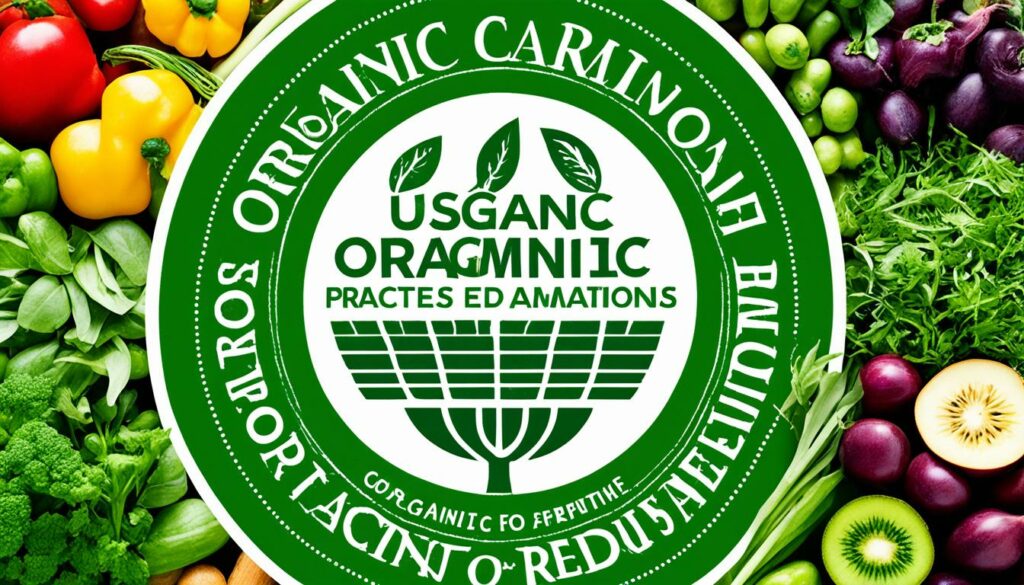
To follow USDA organic laws, there are important steps to take. After March 2024, all organic trades in the US need Organic Certificates of Inspection or Organic Transaction Certificates. This is part of a new rule aimed at making sure organic products are really organic.
Exporters, producers, and importers sending goods to the US must get an NOP Import Certificate for each shipment.
Those in the organic trade often face challenges that could lead to mistakes. It’s hard to keep all organic paperwork consistent. And making sure you abide by rules in different trade deals, like the Canada-US one, can be tough. Staying informed about changes in USDA organic rules is key to prevent errors.
Keeping good records is vital for following organic rules. With about 30,000 organic operations getting checked every year, detailed record-keeping is a must. Using the Organic Integrity Database helps keep track of certificates and compliance. Don’t forget to have records of your residue testing to prove your crops are pesticide-free.
In conclusion, being thorough and careful with USDA organic regulations is important. Knowing what’s needed, avoiding known issues, and keeping good records make the organic business honest and successful.
Trade deals are key for moving organic products freely between countries. The USDA has deals with Canada, the EU, Japan, and others. These deals make sure everyone agrees on what “organic” means. This stops products needing lots of different papers to prove they’re really organic. Everyone shares in a bigger market for organic goods.
The US and Canada have made it easier to trade organic products. Thanks to this deal, if it’s certified organic in the US, it’s good to go in Canada and the other way around. This opens up more markets and cuts down on paperwork. It helps organic goods move smoothly between the two countries.
The EU and the US have a big pact for organic goods. This pact covers important things like plants, honey, and plant products. It makes life simpler for organic farmers and sellers. There’s less hassle with certifications, and prices can stay fair. This deal makes more organic choices available to everyone, making the market stronger.
Japan and Taiwan have their own deals with the USDA for organic products. The JAS seal and Taiwan’s mark match up with global trading rules. This gives US organic sellers rules they can follow. They know they’re keeping up with the right standards. It helps them sell to more people, especially in Asia.
Grasping these global and organic trade deals is important for US organic farmers looking to grow worldwide. These deals are a big chance to find new markets. They make sure organic goods carry trusted stamps of approval wherever they’re sold.
The National Organic Program (NOP) is key in the organic industry, run by the Agricultural Marketing Service (AMS). Its job is to set and keep organic standards in the U.S. and abroad. These standards make sure organic rules are followed well and everywhere.
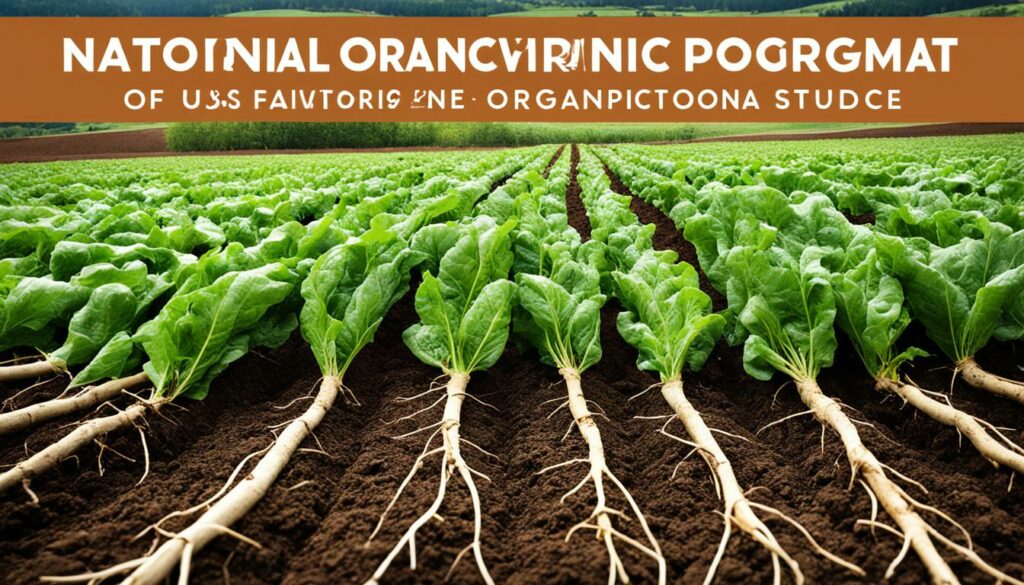
The NOP checks that foods, including ones from other countries, meet very high standards. Since 2013, they’ve asked inspectors to test 5% of farms and businesses each year for certain residues. This makes sure organic food is truly grown the right way.
For example, if there are too many forbidden pesticides on crops, more than the EPA allows, those crops can’t be sold as organic. They must go to normal markets. This careful checking keeps organic foods safe and real for buyers.
Also, the NOP asks people to share if they think someone is breaking organic rules. This keeps organic products true. It also lets everyone help keep the high standard of organic farming.
The NOP looks after many parts of the organic world, like farm producers and food handlers. If someone sells less than $5000 of organic goods a year, they don’t need a full organic check. This helps smaller businesses. It also says that shops selling packed organic food should keep good records to prove they’re truly organic.
An important role of the NOP is to make sure that everyone keeps great records. These records need to show they’re following organic rules and be ready for checks. Records have to be kept for five years. This helps keep the organic supply chain honest and traceable.
There are four different organic labels based on the amount of organic stuff in a product. This makes it easier for customers to choose. Plus, the NOP works with many countries. They aim to make trading organic goods easier while keeping the high U.S. standards.
From March 19, 2024, the NOP will do even more to check on organic businesses. They’ll surprise visit at least 5% of them. And, they’ll ask everyone to keep better records and fight fraud. This will make sure the organic label always means truly organic.
The NOP does a big job to make sure we trust the USDA organic label. By sticking to strong rules, they look out for the people making, selling, and buying organic goods. This helps the organic world stay true to its values.
Exporting organic produce needs careful planning. This includes meeting very specific standards and rules. To make things easier, follow clear steps. These steps cover getting ready to export, putting on the right labels, and clearing customs.
The first step is getting the right certifications. These certifications show that your produce meets USDA organic standards. Both the sellers and buyers need to be on a special list. They get a unique number for each sale. This helps to track the produce.
If your yearly organic sales are $5,000 or less, some steps are not needed. Small farms and some shops may not need all the usual paperwork. But, they still have to show that their products are organic. They must meet the standards too. Doing this right early on can stop problems later.
Accurate labeling is vital for exporting organic goods. It shows buyers that the products are truly organic. Make sure items are clearly marked as organic on their packaging and paperwork. It’s the job of those bringing the products in to check the labels too.
To label correctly, you must know the USDA rules well. Good labeling builds trust and helps products sell better.
Knowing how customs works is key to selling in the US. A new rule starts on March 19, 2024. It makes checks on organic imports harder. Your imports must pass checks and have the right health papers.
You must also have the right codes, check the products’ quality, and label them correctly. Following customs rules well makes it easier to get your products in. It keeps your products true to their organic promises.
If you want to sell in the US, follow these steps carefully. They can help you sell organic goods there successfully and for a long time.
The US organic food market is complex and always changing. Studying the market lets us see how it grows, what people like, and the problems and chances ahead.

In recent years, the organic food market has been booming. The US has seen organic sales rise by 8% annually, hitting over $52 billion last year. People prefer organic products, especially fresh fruits and veggies, spending $19.2 billion on them.
The area of land for organic crops has almost doubled since 2011, now covering 3.6 million acres. This growth shows how important organic farming is in meeting demand. In 2021, fruits and vegetables made up the majority of sales, with other popular items being dairy, eggs, and beverages.
Consumer choices heavily influence market trends. By 2016, over 80% of US homes planned to buy organic food, especially younger people. The online sale of organic foods has also increased, from 2% in 2012 to 6% in 2020.
Organic items are usually more expensive than regular ones. Studies have shown that for most products, the price difference is over 20%. However, people are willing to pay because they see the value in healthier and eco-friendly products.
The market’s growth faces some challenges. Organic farms are more costly to run, needing careful resource use and new farming techniques. Meeting strict regulations and keeping products truly organic are challenges too.
But, there are also many opportunities. Producers can use trade deals and certifications to meet the increasing demand for sustainable foods. By selling online, they can reach more customers beyond traditional supermarkets.
This growing demand for organic goods can help expand the market both in the US and worldwide. Working with other countries can boost the visibility of US organic products around the globe.
Sustainable agriculture is more than a trend. It’s about saving our planet for the coming generations. Organic farming is key here, as it balances ecology with making sense financially. A study by the Rodale Institute found that organic farms can keep 3500 pounds of CO2 per acre from the air each year. This shows organic farming’s crucial role in fighting climate change.
Choosing organic farming helps cut down on harmful chemicals. By not using synthetic pesticides, herbicides, and fertilisers, organic farming helps keep our food and water clean. It also makes the food we eat healthier. Research shows that organic foods are richer in nutrients than foods grown with chemicals.
Organic farming doesn’t just help the environment. It also saves money by not needing expensive synthetic chemicals. And as more people look for healthy, eco-friendly products, organic markets grow. This is good news for both consumers and farmers.
“Regenerative Organic Certification (ROC) elevates agricultural practices beyond traditional organic certification. It aims to enhance biodiversity, improve soil health, and promote fair labour practices.”
India is a big name in organic farming worldwide. It leads in the number of farmers who go organic. Sikkim led the way by becoming completely organic in 2016. But organic farming covers just 2% of India’s farmable land. This shows there’s a lot more room for growth.
In India, the demand for organic foods and government backing has led to more eco-friendly farming. Items like sugar, coffee, oils, and spices are hot exports. Supporting this, the APEDA runs the NPOP, which encourages and monitors organic exports.
Choosing organic food and supporting eco-friendly farming means a better tomorrow. It’s a win-win. The planet gets healthier, and we get better food. Plus, it’s good for the wallet too.
The Organic Integrity Database is crucial. It is managed by the National Organic Program (NOP). It offers detailed, up-to-date facts on certified organic operations. This database boosts transparency and tracks products from the farm to the market. This helps to lower the chances of organic fraud.
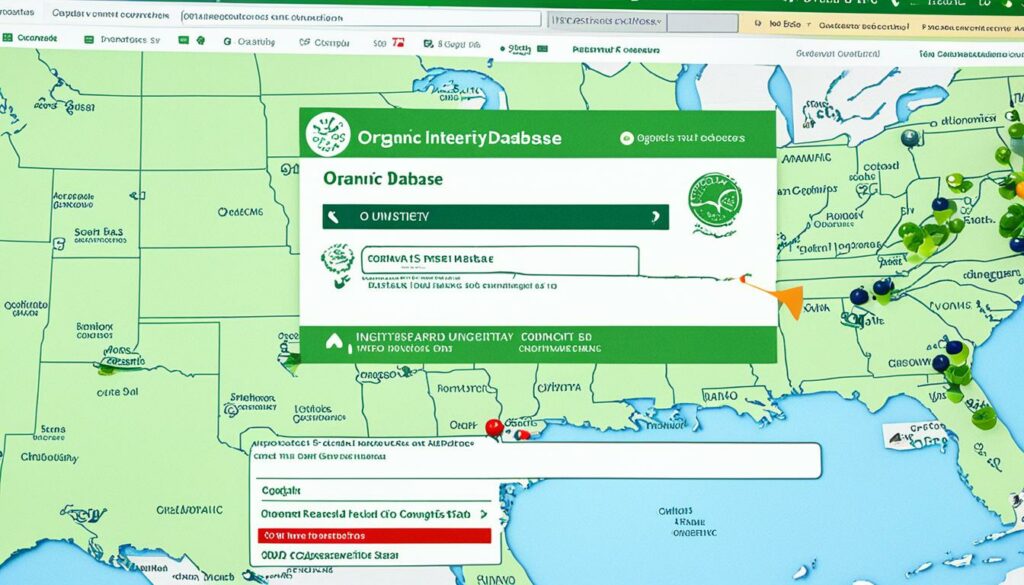
The database organises operations by the types of products they handle. This includes Crops, Livestock, Wild Crops, and Handling. Such careful sorting is key for tracing organic items. It ensures products are truly organic as they move through the supply chain. The use of electronic certificates and special modules, like the Trade Partner module, strengthens this process. This module became available in May 2023.
Below is a summary of the different operation statuses and certifiable areas within the database:
| Status | Certification Scope |
|---|---|
| Certified | Crops, Livestock, Wild Crops, Handling |
| Surrendered | Crops, Livestock |
| Revoked | Crops, Handling |
| Suspended | Livestock, Wild Crops |
Getting to the database makes tracing organic goods far easier. Monthly data snapshots are downloadable from the Data History page. This benefits users, like USDA-Accredited Certifying Agents. They can stay up-to-date with the latest certification reviews and sector changes.
The USDA Agricultural Marketing Service funds the Organic Integrity Database. This funding ensures the database runs smoothly and keeps improving. Additionally, the USDA Organic Integrity Learning Center provides free online training. It helps with professional growth in using the database, offering smart tips for effective platform use.
Success in exporting organic produce to the US means understanding US and global organic standards. The USDA has deals with various countries. This makes exporting easier by not needing different certifications.
On March 19, 2024, the Strengthening Organic Enforcement (SOE) Final Rule brought big changes. Now, businesses that move organic products must meet more rules. This ensures they always meet USDA standards. The NOP checks often and has a strict way for people to report if rules are broken.
Trade agreements are vital. Take the JAS seal in Japan, for instance. Only JAS-certified people or US exporters working with them can use this seal. To send products to Japan, they have to be 95% organic and get their final touches in the US. This makes selling to the international organic market tough but rewarding.
“The sales of organic products in the United States grew by 14.2% in 2020, representing an increase of $1 billion, reaching a value of $8.5 billion.”
In 2021, 44 million pounds of organic produce were exported. This boosted the market a lot. Bananas were the top imported fruit, making up over 24% of all organic imports. This shows how crucial it is to have good export plans worldwide.
| Exported Organic Produce (2021) | Percentage (%) |
|---|---|
| Bananas | 53.1 |
| Avocados | 7.7 |
| Mangoes | 5.8 |
| Blueberries | 5.0 |
| Squash | 4.3 |
To succeed in the international organic market, obey trade regulations and watch what customers like. Always follow strict certification rules. Doing this makes exporting smooth and profitable.
Exporting organic produce is no easy task, facing challenges mainly in rules and how goods move from farm to market. It’s key to tackle these issues to keep the goodness and quality of organic goods high.
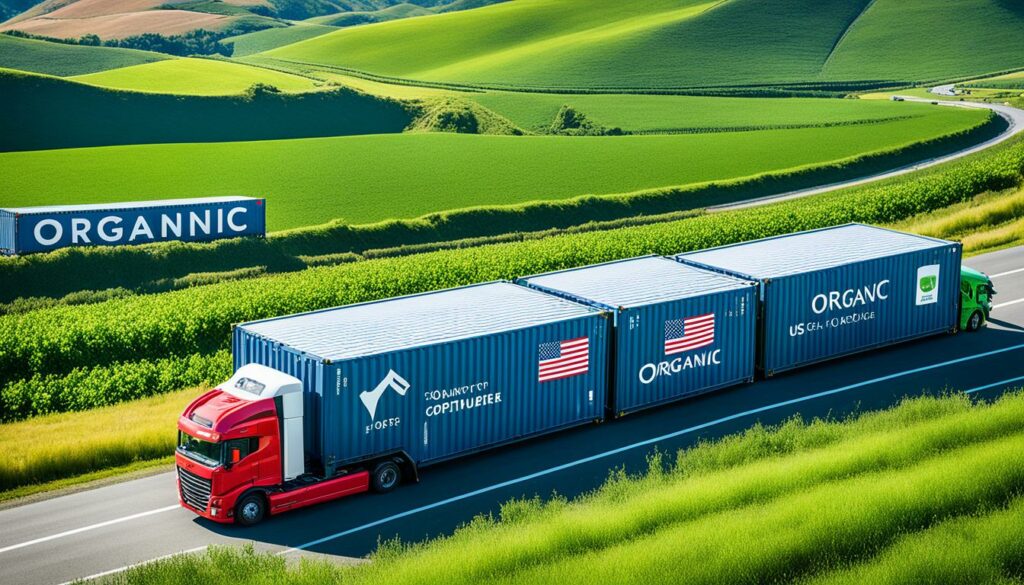
Staying on top of changing organic rules is a major barrier. Recently, the US market grew to $43 billion because of an 8.4% sales jump in one year. To export, farms must meet the set rules by USDA. They also need to fit both American and global organic standards.
The journey from farm to fork for *organic produce* is long and complex. Things like sustainable methods and quality checks must run smooth. This means careful transport, keeping things cold when needed, and following laws at borders.
The demand for making sure the path is clear has never been higher. For example, since 2013, organic corn imports are up 93.7% yearly. Organic soybean imports have also seen a big annual increase since 2011, at 36.7%.
Solving these issues requires smart plans. Using new tech helps keep track of goods better, which makes things move easier. It’s also about being very organised before shipping out, which cuts down on any hold-ups and keeps the goods safe.
| Year | US Organic Food Sales | Certified Organic Acreage | Organic Corn Imports | Organic Soybean Imports |
|---|---|---|---|---|
| 2000 | $7.8 billion | 1.8 million acres | N/A | N/A |
| 2016 | $43 billion | 5 million acres | $160 million | $250 million |
Health inspections and certifications play a big part in selling organic products abroad. Meeting high standards is key. It keeps the organic market safe and trustworthy.
Sanitary certificates are a must for exporting organic items. They show products are healthy and pest-free. Regularly checked by inspectors and governed by the USDA, these steps ensure safety and trust.
Phytosanitary certificates are also very important. They check that exported organic items follow specific rules. This guarantees their wholesomeness and meets global standards. By auditing supply chains, we make sure no tricks are played, securing trust and a strong organic market.
If you’re exporting organic goods, you have to know these checks. Businesses can show their products are genuine USDA organic. This makes consumers trust the products more.
It’s vital that agricultural exports meet strict grading and quality standards. This keeps organic produce at the top. Standards look at size, quality, and the stage of growth. They help build trust with customers who expect top-notch organic items.
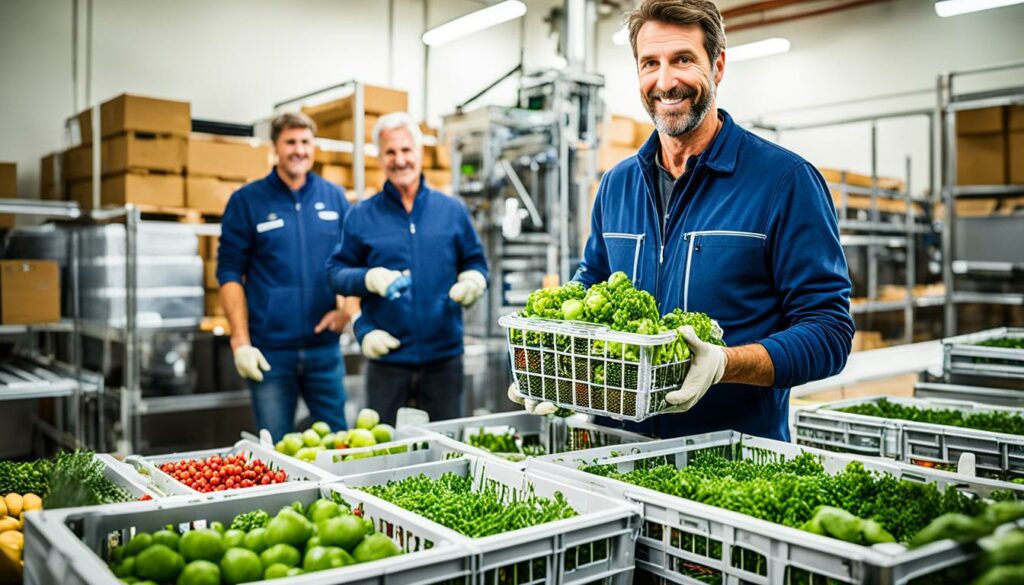
Following precise grading standards is key for the organic sector. For instance, butter and cheese have held Grade AA, A, or B since 1947. The U.S. Extra Grade for dairy started in 1952. These standards apply to fruits, veggies, and dairy. They ensure smooth export processes.
Organic quality control makes sure products labelled “organic” are minimum 95 percent certified. “Made with organic” goods must contain at least 70 percent organic materials. There are also inspection grades for processed fruits and veggies since 1973. This makes sure products are high in quality and safe.
Also, it’s crucial to feed livestock 100 percent organic feed. Plus, ruminants must spend at least 120 days grazing. This is essential for quality assurance.
Producers have to keep up with organic quality control. This ensures their exports are of the top quality. With strong standards and checks in place, the organic label maintains its excellent reputation.
Getting organic products labelled right is key for meeting the law and making customers trust you. Different labels like “100 Percent Organic” or just “Organic” mean varying amounts of organic stuff inside. So, it’s vital for producers and marketers to clearly show what their goods are made of.
If they don’t, they could face legal issues or lose the trust of their customers.
To follow the rules, if something says it’s “100 Percent Organic,” it really should be all organic. Anything less might not be what you think. For the label “Organic,” it’s okay to have up to 5 percent nonorganic stuff.
Let’s not forget about textiles, honey, mushrooms, and pet food. They all have to meet strict USDA rules too. If a producer sells under $5,000 of organic stuff a year, they don’t need certification. But they still must follow the same organic rules and keep good records.
Good marketing is key to selling organic products in a busy market. Putting the organic stamp front and centre can catch the eye of those who care about their health. Talking about the benefits to the environment and how organic farming keeps it real can win over the green crowd.
Being clear and truthful in your marketing can help customers see the real value in a certified organic product.
Marketing strategies should also show the pluses of organic farming. This means no synthetic pesticides or GMOs. It also means supporting soil health and plant and animal diversity. Using the internet and social media can help reach more people. Sharing stories and good reviews can keep loyal customers coming back for more.
So, sticking to the organic label rules and having good marketing plans can boost trust and help you reach more people. This is vital for doing well in today’s market.
Green supply chain management plays a big role in selling organic foods. It focuses on methods that are good for the environment. This includes finding materials responsibly, using less energy, and creating less waste. People who buy organic foods care a lot about how they’re made.
Food production worldwide causes a lot of CO2 emissions, hurting our planet. About 6% of this comes from moving food around, mainly fruits and vegetables. Using water more wisely, like with drip irrigation, can help farms produce more while using less water. It’s great for the environment and makes a big difference in reducing carbon emissions.
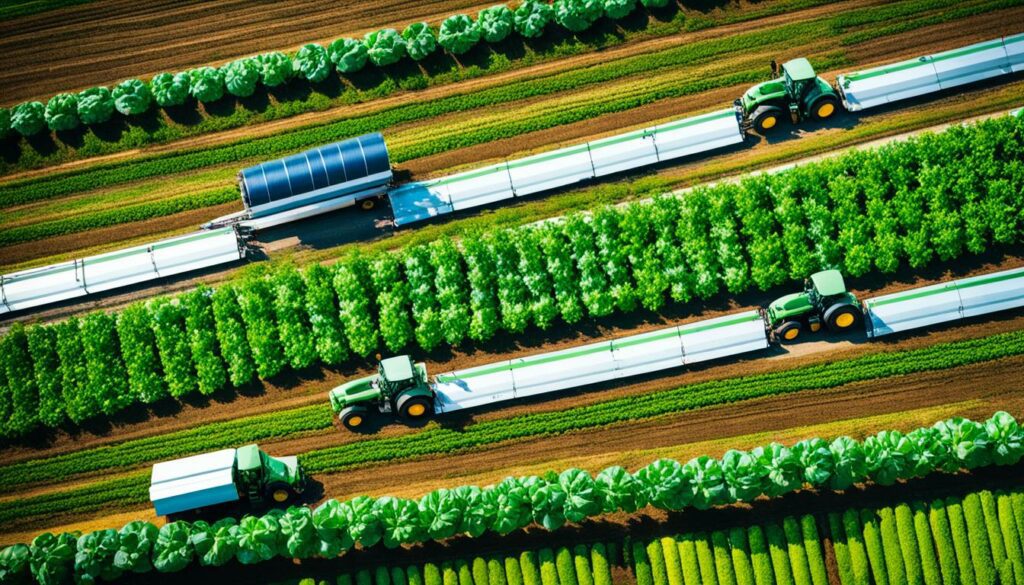
In India, organic farming is growing fast thanks to a government scheme. This has made 2 lakh hectares ready for eco-friendly farming. With this support, India’s organic food business has grown a lot. This includes more exports of organic products, which reached $515 million in one year.
In Europe, people are choosing organic and local foods more. Because of this, supermarkets are asking for proof that food suppliers are eco-friendly. They are also using packaging that’s better for the planet, like cardboard. By selling more organic food, supermarkets are meeting the demand for sustainable choices.
A study in South Carolina showed that working closely with delivery companies cuts costs. It also makes the supply chain more efficient. This makes organic food cheaper and the process of getting it to stores greener.
To meet the growing demand for organic items, a green supply chain is key. It helps companies stand out and does good for the Earth. Choosing environmentally friendly ways benefits everyone.
The journey to exporting organic products to the United States is about following strict rules and using sustainable methods. The US’s love for organic food has grown a lot. Sales jumped from $3.6 billion in 1997 to $26.7 billion by 2010. This shows a big chance for those wanting to export organic goods.
Understanding international organic standards is crucial. In places like Italy and the US, many acres grow organic products. And countries such as Germany and the UK show the value of being certified. The late 1990s saw a big increase in people buying organic food, especially fruits and veggies.
Using sustainable methods is good for both the earth and business. Many Americans choose organic for health and environmental reasons. Countries like Denmark and Switzerland really value eco-friendly practices. Staying alert to changing regulations and smart marketing is key. It keeps organic products trusted and successful in the world market.
Getting certified organic is key for farmers. It shows they meet high standards for organic farming. This allows them to sell in new places. It also tells buyers the products they get are truly organic and top quality.
The USDA organic seal means a lot. It’s a stamp from the US government. It tells us the product met tough organic standards from start to finish.
To keep your goods as organic, you need to follow some steps. Stick to the certification rules closely. Keep paperwork in order and watch over everything. This includes making sure your goods are safe from harm when they’re shipped.
To export in line with USDA rules, there’s a lot to do. You must have the right certs and labels. Make sure your products meet health and safe to eat standards. And you must show your shipping docs are all in order. Expect checks and visits to keep your cert in check.
Knowing about deals like the US-Canada and talks with the EU and others is important. These deals ease trading by cutting the red tape on what makes organic products, giving you more market chances.
The NOP, run by the USDA’s AMS, is the boss on what’s organic. It makes sure everyone plays by the same rules, from farm to store. This keeps organic labels trusted by shoppers.
The first steps are getting the right certs and knowing how to prep for export. You also need to follow label and packing rules. And don’t forget about customs and making sure the health docs are all set.
The US organic food scene is booming, thanks to shoppers wanting more organic goods. Knowing what buyers like and using trade deals well can boost your sales.
Sustainable farming, with an eye on caring for the land and using resources wisely, makes organic goods more appealing. It matches what shoppers want and helps you stand out worldwide.
The Organic Integrity Database, run by the NOP, is like a book on who’s certified organic. It makes sure the organic journey is clear and true. This stops fraud and helps people trust organic labels.
You might run into rule changes and tough trade needs. Plus, getting your goods safely to the buyer can be tricky. Overcoming these challenges needs smart plans and by-the-book work.
Health checks and certs are a must for your organics. Your goods must be clean from pests and up to health codes. For meats and eggs, they need to meet the same safe to eat standards.
Fitting to USDA quality rules is key. It makes sure your goods match what buyers expect. This keeps your organic brand strong and helps you keep up in the market.
Paying attention to how you label your goods is crucial. Telling your green story well can sway buyers. It also makes you a strong player in the organic market.
Going green in how you get your goods out matters a lot. Think green sourcing, saving energy, and cutting waste. This green commitment speaks to organic buyers and makes your goods more wanted.